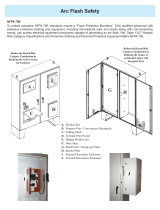
10
Installation and Operation Manual
Terminals, Wire Size, and
Installation Torque
Terminals are provided for phase (line), neutral, and equipment ground
connections. The SPD terminals accept a range of 12 AWG (3 mm
2
) to 2 AWG
(34 mm
2
) copper wire for phase, neutral, and ground connectors. Torque
connections to the following values.
Branch Circuit Overcurrent
Protection and Disconnect Means
A branch circuit Overcurrent Protection Device (OCPD) either in the form of a
circuit breaker or fuse, must be provided for the SPD. The branch circuit OCPD
should either provide or include a disconnecting means.
Since the current drawn by the SPD during standby operation is negligible, the
SPD can be connected to a dedicated, separate branch circuit or connected to
a suitable existing branch circuit.
• When connected to a separate, dedicated branch circuit, the OCPD
setting must be selected to protect the conductors feeding the SPD.
• When connected to an existing branch circuit, the conductors connected
to the SPD must have an ampacity not less than the setting of the
existing OCPD. Refer to Terminals, Wire Size, and Installation Torque
section above, for the maximum conductor cross-section that can be
connected to the SPD.
During overvoltage surge diversion, current will flow through the SPD. The
branch circuit OCPD must pass this current without tripping for the SPD to
function properly.
For further information concerning coordination of the OCPD with the SPD,
refer to the Caution statement “Loss of Branch Circuit Power/Loss of Surge
Suppression” on page 4.
Integral Switch The integral switch is a mechanical means for qualified electrical personnel to
isolate the entire surge suppressor to service the device’s components. The
switch opens the phase and neutral connections to the surge protective device.
The integral switch feature allows the SPD to be isolated for service without the
necessity of interrupting power on the entire branch circuit.
Turn switch handle to the OFF (O) position prior to opening the door of the unit.
With the handle in the OFF (O) position, the SPD will be disconnected from the
circuit and the circuit will not have surge suppression. Once the absence of
voltage is verified, maintenance may now be performed inside the SPD
enclosure. Upon completion of repairs, close the door of the unit and turn the
handle to the ON (I) position.
Location of Surge Protective
Device (SPD)
Install SPDs on the load side of the main Overcurrent Protection Device
(OCPD) to comply with NEC Article 285 for Type 2 SPDs.
Locate the SPD as close as possible to the circuit being addressed to minimize
the wire length and optimize SPD performance. Avoid long wire runs so that the
device will perform as intended. To reduce the impedance that the wire displays
to surge currents, the phase, neutral, and ground conductors must be routed
within the same conduit and tightly bundled or twisted together to optimize
device performance. Avoid sharp bends in the conductors. See Figure 2.
Table 3: Terminal Torque
Power Connection Torque
AØ, BØ, CØ and N
35 lb-in. (4 N•m)
Ground
Electrical




















